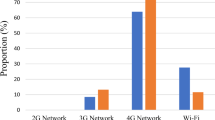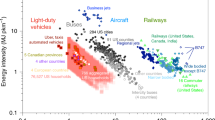Abstract
Epidemiologic studies of mobile phone users have relied on self reporting or billing records to assess exposure. Herein, we report quantitative measurements of mobile-phone power output as a function of phone technology, environmental terrain, and handset design. Radiofrequency (RF) output data were collected using software-modified phones that recorded power control settings, coupled with a mobile system that recorded and analyzed RF fields measured in a phantom head placed in a vehicle. Data collected from three distinct routes (urban, suburban, and rural) were summarized as averages of peak levels and overall averages of RF power output, and were analyzed using analysis of variance methods. Technology was the strongest predictor of RF power output. The older analog technology produced the highest RF levels, whereas CDMA had the lowest, with GSM and TDMA showing similar intermediate levels. We observed generally higher RF power output in rural areas. There was good correlation between average power control settings in the software-modified phones and power measurements in the phantoms. Our findings suggest that phone technology, and to a lesser extent, degree of urbanization, are the two stronger influences on RF power output. Software-modified phones should be useful for improving epidemiologic exposure assessment.
This is a preview of subscription content, access via your institution
Access options
Subscribe to this journal
Receive 6 print issues and online access
$259.00 per year
only $43.17 per issue
Buy this article
- Purchase on Springer Link
- Instant access to full article PDF
Prices may be subject to local taxes which are calculated during checkout



Similar content being viewed by others
References
Andersen J.B., and Pedersen G.F. The technology of mobile telephone systems relevant for risk assessment. Radiation Protection Dosimetry 1997: 72 (3–4): 249–257.
Balzano Q. Exposure metrics for RF epidemiology: cellular phone handsets. Radiation Protection Dosimetry 1999: 83: 165–169.
Berg G., Schuz J., Samkange-Zeeb F., and Blettner M. Assessment of radiofrequency exposure from cellular telephone daily use in an epidemiological study: German Validation study of the international case-control study of cancers of the brain—INTERPHONE-Study. J Expo Anal Environ Epidemiol 2005: 15 (3): 217–224.
Breckenkamp J., Neitzke H.P., Bornkessel C., and Berg-Beckhoff G. Applicability of an exposure model for the determination of emissions from mobile phone base stations. Radiat Prot Dosimetry 2008: 131 (4): 474–481.
Burkhardt M., and Kuster N. Review of exposure assessment for hand held mobile communications devices and antenna studies for optimized performance. In: Stone W.R. (Ed.). Review of Radio Science 1996–1999. Oxford University Press: Oxford, New York, 1999, pp. 873–918.
Cardis E., Richardson L., Deltour I., Armstrong B., Feychting M., and Johansen C., et al. The INTERPHONE study: design, epidemiological methods, and description of the study population. Eur J Epidemiol 2007: 22: 647–664.
Erdreich L.S., Van Kerkove M.D., Scrafford C., Barraj L., Shum M., and McNeely M., et al. Factors that influence RF power output of GSM mobile phones. Radiat Res 2007: 168: 253–261.
Funch D.P., Rothman K.J., Loughlin J.E., and Dreyer N.A. Utility of telephone company records for epidemiologic studies of cellular telephones. Epidemiology 1996: 7 (3): 299–302.
Gosselin M.-C., Zefferer M., Crespo-Valero P., Christ A., Kuehn S., and Kuster N. Correlation of the exposure of mobile phones assessed in sam by applying standard procedures with the sar in anatomical human heads. In Proceedings of the 31st Annual Meeting of the Bioelectromagnetics Society (BEMS 2009), June 2009.
Hillert L., Ahlbom A., Neasham D., Feychting M., Jarup L., and Navin R., et al. Call-related factors influencing output power from mobile phones. J Expo Sci Environ Epidemiol 2006: 16 (6): 507–514.
Inyang I., Benke G.P., McKenzie R.J., Anderson V., and Abramson M.J. Comparison of measuring instruments for radiofrequency radiation from mobile telephones in epidemiological studies: Implications for exposure assessment. J Expos Sci Environ Epidemiol 2007: 18 (2): 134–141.
Kühn S., Keller V., Sulser C., and Kuster N. Over-the-air performance of GSM cellular phones only marginally affect the user's average exposure in gsm networks. IEEE Transactions on Antennas and Propagation (accepted).
Kühn S., Kelsh M.A., Kuster N., Sheppard A.R., and Shum M. Statistical evaluation of the correlation between various mobile phone design parameters and human exposure to EMF. Rad Res (submitted).
Kühn S., and Kuster N. Field evaluation of the human exposure from multi-band, multi-system mobile phones, IEEE transaction on electromagnetic compatibility, 2009 (submitted).
Kuster N., and Schönborn F. Recommended minimal requirements and development guidelines for exposure setups of Bio-experiments addressing the health risk concern of wireless communications. Bioelectromag 2000; 21: 508–514
Kuster N. Latest progress in experimental dosimetry for human exposure evaluations and for characterization and optimization of exposure setups used in biological experiments. In: Legris C. (Ed.). Communication Mobile—Effects Biologique. CADAS, Académie des Sciences, Paris, 2001, pp. 43–69.
Lehman Brothers. Global Wireless Handset Matrix (Brochures). March 2001. April 2002. May 11, 2004.
Lonn S., Forssen U., Vecchia P., Ahlbom A., and Feychting M. Output power levels from mobile phones in different geographical areas; implications for exposure assessment. Occup Environ Med 2004: 61 (9): 769–772.
Morrissey J.J. Radio frequency exposure in mobile phone users: implications for exposure assessment in epidemiological studies. Radiat Prot Dosimetry 2007: 123 (4): 490–497.
Radon K., Spegel H., Meyer N., Klein J., Brix J., and Wiedenhofer A. et al. Personal dosimetry of exposure to mobile telephone base station? An epidemiologic feasibility study comparing the Maschek dosimeter prototype and the AntennesaDSP-090 system. Bioelectromagetics 2006: 27: 77–81.
Rothman K.J., Chou C.K., Morgan R., Balzano Q., Guy A.W., and Funch D.P., et al. Assessment of cellular telephone and other radio frequency exposure for epidemiologic research. Epidemiology 1996: 7 (3): 291–298.
Takebayashi T., Varsier N., Kikuchi Y., Wake K., Taki M., and Watanabe S., et al. Mobile phone use, exposure to radiofrequency electromagnetic field, and brain tumour: a case-control study. Br J Cancer 2008: 98 (3): 652–659.
Wiart J., Dale C., Bosisio A.V., and Le Cornec A. Analysis of the influence of power control and discontinuous transmission on RF exposure with GSM mobile phones. IEEE Trans Electromag Compatibility 2000: 42: 376–385.
Acknowledgements
We thank Dr. Howard Cyr and Abiy Desta from the Radiation Biology Branch, Center for Device and Radiological Health, of the US Food and Drug Administration (FDA), for their technical oversight and support, and our Scientific Advisory Panel (Joseph Bowman, Joe Wiart, Dimitrios Trichopoulos, Charles Poole, and Richard Tell) for review and input on study design and research approach. We also acknowledge Dr. Joseph Morrissey, Motorola Research Labs, who provided the software-modified phones and technical support for this equipment, Kathy Dyson for her research assistance on data collection and management, and Rick Nelson for editorial assistance.
Author information
Authors and Affiliations
Corresponding author
Ethics declarations
Competing interests
This research was conducted through a collaborative research agreement (CRADA) between FDA and CTIA, a non-profit organization of the wireless communications industry. Technical oversight was provided solely by the FDA staff and an independent Scientific Advisory Panel. CTIA funded the work but was not involved in study methodology, data acquisition, analysis, interpretation, or manuscript preparation. Several authors have provided research and consulting services for mobile phone manufacturers, service providers, and governmental bodies on unrelated projects.
Rights and permissions
About this article
Cite this article
Kelsh, M., Shum, M., Sheppard, A. et al. Measured radiofrequency exposure during various mobile-phone use scenarios. J Expo Sci Environ Epidemiol 21, 343–354 (2011). https://doi.org/10.1038/jes.2010.12
Received:
Accepted:
Published:
Issue Date:
DOI: https://doi.org/10.1038/jes.2010.12
Keywords
This article is cited by
-
Development of a source-exposure matrix for occupational exposure assessment of electromagnetic fields in the INTEROCC study
Journal of Exposure Science & Environmental Epidemiology (2017)
-
Instruments to assess and measure personal and environmental radiofrequency-electromagnetic field exposures
Australasian Physical & Engineering Sciences in Medicine (2016)
-
Mobile telephones: A comparison of radiated power between 3G VoIP calls and 3G VoCS calls
Journal of Exposure Science & Environmental Epidemiology (2015)
-
Complexities of sibling analysis when exposures and outcomes change with time and birth order
Journal of Exposure Science & Environmental Epidemiology (2014)



